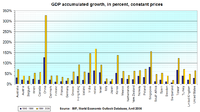
Photo from wikipedia
The direct and indirect effects of transportation infrastructure have a positive impact on the economic growth and development of a country. Apart from improving accessibility, infrastructure development brings along trade… Click to show full abstract
The direct and indirect effects of transportation infrastructure have a positive impact on the economic growth and development of a country. Apart from improving accessibility, infrastructure development brings along trade and investment opportunities to the previously unconnected regions. It also provides access to goods, services, and employment opportunities in these regions through the multiplier effect. In this paper, a panel of data is employed using the unit root, cointegration, and Granger Causality (GC) model to test whether causal linkages between economic growth and transportation infrastructure exist at national and provincial level. The findings suggest that in the short run, there is no causality between the two variables at the national level, however, a unidirectional causality from economic development to infrastructure investment exists in the long run. At the provincial level, bidirectional causality in the rich and much developed provinces exists, whereas a unidirectional GC exists from economic growth to transportation infrastructure in the underdeveloped provinces. The outcomes of the model shed light on the fact that infrastructure investment per se is not sufficient to boost the economic activity in the underdeveloped regions of Pakistan. A cointegrated investment package is needed, targeting not only infrastructure but also the social and technological development, which can help these regions to realize the promotion of economic growth in the long run.
Journal Title: Transportation Letters
Year Published: 2017
Link to full text (if available)
Share on Social Media: Sign Up to like & get
recommendations!